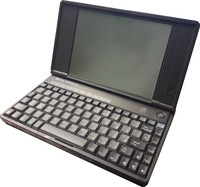HP OmniBook 300
| Home > Browse Our Collection > Computers > Hewlett Packard > HP OmniBook 300 |
|
The OmniBook 300 was made by the calculator division of HP. The OmniBook was indestructable, had a good keyboard and was, for the time, very small, light and portable. It also had two new innovations. First, system files, operating system and office suite were installed not on the hard drive, but on a theoretically replaceable ROM card. The OmniBook had and needed only 2 MB of RAM because everything installed in ROM, executed in ROM, and didn't use memory. The second innovation was a pop-out mouse. You pressed a button, and out it popped. Control of the mouse pointer came not from registering movement under the mouse, as most mice do, but by the movement of the "popsicle stick" piece of plastic that connected mouse to laptop. The OmniBook had a nine-inch, black-and-white VGA screen, was 6.4 x 11.1 x 1.4 inches. At the time of its introduction in 1993, the HP Omnibook 300 was the smallest and lightest PC on the market to feature a full-size keyboard and full VGA (video graphics array) screen. It weighed only 2.9 pounds and was based on the Intel 386 processor. It included Microsoft Excel, Microsoft Word and a pop-up mouse.
PC World in its list the 25 Greatest PCs of All Time included the OmniBook 300 at number 18 with the following quote "The innovative OmniBook 300 wasn't just one of the first subnotebooks--it was one of the most innovative hardware designs ever, albeit one that didn't prove particularly influential. Weighing 2.9 pounds, the system stored Windows 3.1, Excel 4.0, Word 2.0, and MS-DOS 5.0 in ROM memory rather than on a hard drive; this allowed it to boot up instantly. User storage was solid-state too, on a 40MB PCMCIA Type III hard disk or a 10MB PCMCIA Type II flash-disk drive. Productivity was a central theme for the OmniBook, which started at $1950. The unit came with LapLink Remote Access and HP's organisational tools (contacts, appointments, and a financial calculator, same as in the HP 100LX), and provided one-button access to all applications. It also had a unique integrated mouse that popped out of the laptop's right side on a thin piece of plastic; the design eliminated the need for an annoying mouse cable, but the mouse was small and awkward to move about."
The picture with the pen is purely to show the relative sizes. The close-up shows clearly the unique pop out mouse.
Manufacturer: Hewlett Packard Comment on This Page Magazines RELATED to HP OmniBook 300 in our Library
Other Systems Related To HP OmniBook 300:
This exhibit has a reference ID of CH53200. Please quote this reference ID in any communication with the Centre for Computing History. |
Click on the Image(s) For Detail
|
























